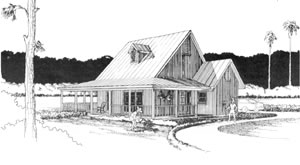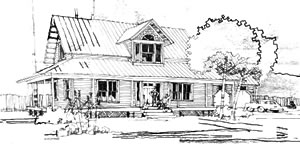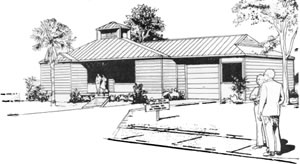
![]()
 |
The Florida Solar Energy Center and the Governor’s Energy Office are pleased to present “The Florida Cracker Style” – turn-of-the-century charm with state-of-the-art energy efficiency.
In 1990, the Florida Governor's Energy Office and the Florida Solar Energy Center asked home designers to return to Florida's past in creating energy-saving homes for the present — and for Florida's future. A statewide design competition resulted in these three winning Cracker-style designs, which offer affordability, energy performance and historical architectural elegance.
Ideas from the Past
Before the advent of air conditioning, Florida settlers counted on nature for cool comfort. They surrounded their homes with wide verandas that shaded walls and windows. They built in lots of windows that were open to cooling breezes but protected from summer sun and seasonal rains. And they topped off their houses with clever cupolas and clerestories to vent interior heat. These common-sense design elements are the roots of Florida’s original architectural statement – the Cracker style. Why “Cracker?” The story goes that many of these early settlers were ranchers who used the “crack” of a whip to round up their cattle – a distinctive sound that became a trademark. Native Floridians came to be called Crackers, and their homes defined what today is known as the Cracker style.
Energy for the Future
Many of the thousands of people who move to Florida each year want homes with a distinctly Florida flair. But typical plan books and builder models usually don’t include the Cracker style, offering instead designs that borrow their architecture from other regions of the country. Unfortunately, most of these plans aren't designed for Florida’s warm, humid climate, so the resulting homes often use much more air-conditioning energy than necessary.
Review the designs below before considering one from another plan book. If one of these plans fits your site and space needs, it could offer a home with much lower operating costs – as well as a refreshing, native-Florida style.
Design Competition
Judging Team
- Walter Mauder — AIA, Chairman; Architect, Bureau of Historical Preservation, Tallahassee
- Fran Arnold — General Contractor and Real Estate Broker, Longwood
- Lyle Fugleberg — AIA, Principal, Fugleberg Koch Architects, Inc., Winter Park
- Gordon Mock — Architect, Ecologic Enterprises, Inc., West Palm Beach
Cost Estimator
- Gary Cook — Building Construction Specialist, Florida Energy Extension Service
Coordinators
- Rob Vieira, Florida Solar Energy Center
- Larry Maxwell, Florida Solar Energy Center
- Daryl O’Connor, Florida Governor’s Energy Office
 |
The Cross Creek
by William Wagner, AIA, Gainesville, Florida
Energy-efficiency and versatility are key features of the Cross Creek. With an entrance that opens to the east, the home site suits lots that face east or south. A mirror image of the design will also fit west-facing sites.
Verandas on two sides bring light and fresh air into the living space, which opens conveniently to a dining area. Outdoor dining is a pleasant option on the adjacent screened porch. Windows on both side, of the well-equipped kitchen keep the cook cool with natural breezes. Windows on opposite walls of the master bedroom provide maximum ventilation during sleeping hours. Another large bedroom does double duty as an office or den. Design options include a garage on the north side and a one-bathroom plan.
The two-bedroom, two-bath Cross Creek offers 1100 square feet of conditioned flour area. Ten-foot-high ceilings and more than 800 square feet of roofed unconditioned area give it a feeling of spaciousness seldom found in other homes of this size.
 |
The Suwannee
by Ronald Haase, Architect, Gainesville, Florida
The Suwannee features two-stories of cracker-style living. In winter, a wood stove helps heat the home, while windows that open to a wrap-around veranda provide ventilation during summer. When air-conditioning is a must, this compact design with its built-in energy features should help keep utility bills to a minimum.
Large kitchen, dining and living areas, along with a versatile back porch, make this house ideal for an active family. Adults can still maintain their privacy with the master suite on the first floor and secondary bedrooms upstairs.
The Suwannee is designed to face north, although it will also provide energy efficiency if sited to the south. The plan features about 1700 square feet of conditioned area.
 |
The St. Johns
by John Hall, Architect, Ormond Beach, Florida
With its spacious living/dining area and two spacious bedroom retreats, the St. Johns is a great choice for a variety of Florida lifestyles-retirees, young couples, single people, roommates, or single-parent/single-child families. The plan includes a large screened porch so everyday living can include insect-free enjoyment of Florida's mild seasons.
The design is ideal for sites that face north or northeast. With 1076 square feet of conditioned floor area, the St. Johns provides lots of space on a small budget. The one-car garage not only offers ample storage space - but by incorporating the optional back garage door, it also becomes a comfortable breezeway that's a great play-space for children and grandchildren.
